Snakebite Red-Necked Keelback (Rhabdophis subminiatus)
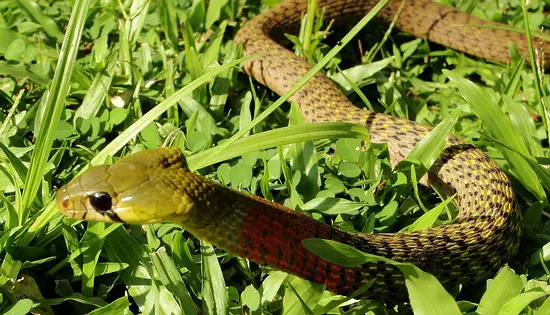
[Page Updated: 10 June 2023]
Red-necked Keelback Snakebite and Envenomation
Red-necked keelback snakes are common in Thailand, and very much in Krabi. They prefer grassy areas on the lowlands and flats, and yet I’ve also seen them on very steep hills at Krabi Tiger Cave Temple. One time I saw a keelback getting chased up the hill by a much smaller skink who wasn’t having it!
A couple of months back I received an email from a concerned father whose son was bitten by a red-necked keelback (Rhabdophis subminiatus) he had found in their neighbor’s garden.
“My son is suffering from nonclotting, severe swelling, and paralysis and is now in ICU, where his vital and neuro signs are ok, but blood not good.”
These snakes have, in the past, not been identified as a dangerous snake. Many people have them as pets, and free-handle them with bare hands. Sometimes these snakes bite, but once they are handled a bit they usually calm down and rarely bite.
There have been some cases in the literature where bites have resulted in hospitalization, and there has been a push to identify these snakes as what they are – venomous, and dangerous.
Colubrids, rear-fanged snakes, are nearly all venomous. Venom is a modified saliva that helps the snake kill and break down the body of its chosen food.
I was excited to have a response from the father of this boy that spent 2 weeks in a Thailand hospital after suffering 2 bites from this snake.
Here’s what I learned after some questions by email…
1. Can you tell anything about how the bite occurred? Was the keelback snake typically calm – and then, out of the ordinary behavior – it bit your son?
Calm, he was showing off to his friends that he can handle snakes, this red-necked keelback was a wild one, not a pet. He has a constrictor, a corn snake and a python as pets, all fairly placid, but the keelback he had no understanding of.
2. Approximately how long did the snake bite down on your son’s hand? Was it less than 1 second? 1-3 seconds? 3-5? 10? 60 or more? This is the most important question because in the past we haven’t seen enough venom transferred from quick bites or even repetitive quick bites…
Between 30-40 seconds I believe. It wouldn’t let go.
3. Did the snake bite more than once that day?
Bit him twice within a few minutes.
4. Did the snake routinely bite your son – often?
First time.
5. Can you tell me approximately how long was the snake? Do you have any photos of it? Can you please send if you do?
No photo I’m afraid, he didn’t mention how long it was, but he will be back from school at the weekend, and I’ll fish more info out of him.
6. Did you get the snake in Thailand? There in Phuket, or where?
Wild snake in his friend’s garden (Phuket).
*******
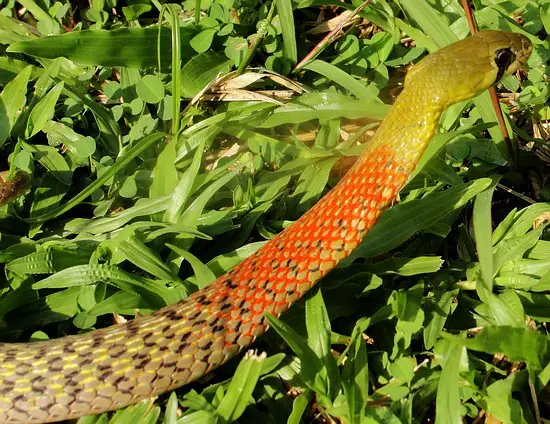
So, here again – the red-necked keelback snake bit down for an extended period of time – 30+ seconds and had time to squeeze a lot of venom into the boy’s hand. Then bit again.
There is no manufactured antivenin for the Rhabdophis subminiatus as it is here in Thailand. In Japan, there is a small amount of antivenin produced to handle bites from their local species. To my knowledge, there has been nobody treated with this antivenin outside of Japan, and I’m sure they would not be all that interested to give up some of their small supply to export to another country.
More information on venom toxicity and treatment after a bite by this snake: R. subminiatus.
Venom Characteristics
(from http://www.afpmb.org/content/venomous-animals-r#Rhabdophissubminiatus)
Venom consists of mainly procoagulants, which can cause renal failure; plus mild neurotoxic factors. Envenomation does not always occur. The bite may be almost painless, with minimal local swelling.
Symptoms of envenomation may include local numbness, headache, nausea, & vomiting; in severe cases, renal failure has caused human deaths. No known antivenom is currently produced.
LD50 for intravenous injection – .125 to .129 mg/kg. That is extremely venomous, in the same category as Bungarus candidus (Malayan Krait), Naja kaouthia (Monocled Cobra), and O. hannah (King Cobra).
One WHO (World Health Organization) publication about the management of venomous snake bites in Southeast Asia mentions the antivenin for Rhabdophis tigrinus in Japan as having some effect on the venom of R. subminiatus. I am not sure if this is strictly for R. subminiatus found in Japan, or not.
Worth a try though if you can get them to send you some antivenin. Otherwise, there is no other option – there is no monovalent antivenin specifically for R. subminiatus.
Japan Snake Institute
Nihon Hebizoku Gakujutsu Kenkyujo
3318 Yunoiri Yabuzuka
Yabuzukahonmachi Nittagun Gunmaken 379-2301
Tel 0277 785193 Fax 0277 785520
Snake-c@sunfield.ne.jp
www.sunfield.ne.jp/~snake-c/
Yamakagashi (Rhabdophis tigrinus) antivenom. Also effective against rednecked keelback (R. subminiatus venom)
I have some time today, and I’m curious what their response will be. I’ll write to them to see whether they could, in an emergency, be able to send some antivenin here to Thailand to treat a bite by R. subminiatus or R. tigrinus.
OK, I’ve written them, let’s see if they respond…
Update 2/11/2016 – No, they did not respond at all. Nothing. Today I was thinking about the topic and decided to write more people to see if I could get some vials of Rhabdophis tigrinus antivenom from Japan to try in treating patients with complications from bites of R. subminiatus.
The following is the letter I’m sending to a number of researchers, scientists, and again, to “The Japan Snake Institute.”
Dear Toru Hifumi,
Greetings from Thailand! I am a snake enthusiast from the USA, living in Thailand for the past 11 years.
I read your paper, “Effect of antivenom therapy of Rhabdophis tigrinus (Yamakagashi snake) bites.”
I have been researching the subject of Rhabdophis envenomation because I have had a few experiences here, helping young boys who were bitten.
In both cases, the victim was a young male child. One was 12 years old, and the other was only 9 years old. Both the boys had kept the snakes as pets and thought them to be harmless.
Both were admitted to hospital intensive care for 10-14 days with bleeding from various orifices and ultimately renal failure.
I have read that your antivenom may help particularly in cases of renal failure.
On two occasions I emailed staff at “The Japan Snake Institute” about possibly purchasing some antivenom to help these boys recover. Unfortunately, I never received any reply from them at all.
I am hoping you will reply favorably after reading this note!
As you know, Thailand has not made antivenom for any snake in the Rhabdophis genus. R. chrysargos and R. nigrocinctus are also found in Thailand, and they may have similarly toxic venom.
I anticipate more emergency situations involving children in the coming year(s) and I must try to help in any way I can.
I am asking you if I can purchase some of the R. tigrinus antivenom for experimental use by hospital staff when patients in Thailand are envenomated by this snake.
We are not seeking to make any profit from this venture, the antivenom will be provided to Thailand hospitals on a case-by-case basis, and at cost (no markup).
As I understand your article to read, each vial of freeze-dried R. tigrinus antivenom, Equine (lot #0001) is able to neutralize the coagulant activity of about 4 mg of R. tigrinus venom.
If we were able to purchase just 10 vials, or even 5, that could be a significant help to patients here in Thailand who need it – especially children.
Would you please respond favorably to this request?
Thank you for your time and concern about what will most certainly be in the near future – a life and death matter.
With highest regards,
Vern J. Lovic
ThailandSnakes.com

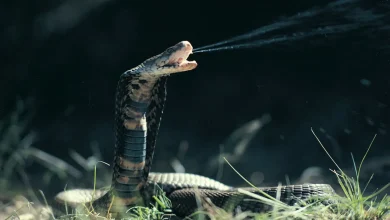
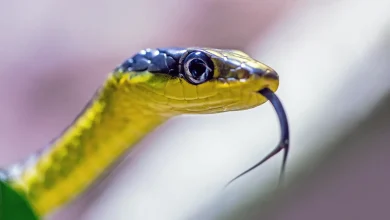

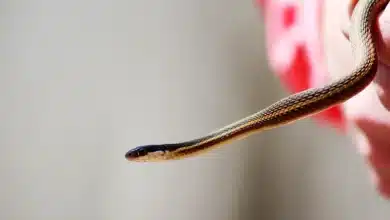
That was back at my house and the kid’d name is Natty, i told him not to touch it and there were 2 keel backs and i all so had a big ball python back then, the same snake bit me but i had no reaction, they were both about 1-1.3 meters long, i knew about the cases but never thought that would have happen to him.
i free handled one before the accident, the snake was like a puppy dog.
Thanks for the interesting article.
I have a couple comments:
1. By far, most colubrids are not dangerously venomous.
2. Colubrids do in fact have a pair of venom glands. They are commonly referred to as the Duvernoy’s gland and all snakes and lizards have this gland. Our venomous specie (ie elapids, viperids, etc.) have evolved a modified Duvernoy’s gland that produces much deadlier venom.
-Evan
I had a very similar experience here in Indonesia. 9 days in ICU.Multiple transfusions etc. Red necks are very common here but nobody,not even Doctors or Herpetologists, is aware that they are venomous.Interestingly, after the bite, I continued with my normal activities for almost 24 hours, including a 4 hour mountain bike ride, before the symptoms forced me to seek treatment.
Interesting Paul. Can you tell us what the venom was affecting? What were your symptoms?
Sorry I took so long to reply. Symptoms were mainly bleeding, from just about everywhere, I was black and blue, with yellow eyes! I had blood coming from my nose, gums and in my urine and feces. The original bite wound continued to bleed for about a week. Blood clot test showed zero clotting and my hemoglobin was about half normal. I needed transfusions of platelets,plasma, and whole blood and, finally some expensive stuff which I forget the name of, but I can dig out my medical records if anyone needs them (I am at the office right now)
Hi Paul,
I’m from Vietnam, and there is a 10 year old kid that i happen to know in the hospital biten by the same snake. He’s suffering now. N the doctor over here can give him any medicine to reduce the venom. He has been in the hospital for a week already. Also his parent from country side n they found out their son got bit after 2 days from the accident
My name Oanh by the way, and pls email me your medical treatment if possible caotuoanh@gmail.com
Thank you very much
Oanh
Hi Paul,
I’m from Vietnam, and there is a 10 year old kid was bitten Red-necked keelback snake. He’s suffering now.
The doctor over here can give him any medicine to reduce the venom. He has been in the hospital for a week already. Also his parent from country side n they found out their son got bit after 2 days from the accident
My name Oanh by the way, and pls email me your medical treatment if possible caotuoanh@gmail.com
Thank you very much
Oanh
The Japanese produce an anti-venin for this snake in Japan in very small quantities. I don’t think it is available to buy, but you might write someone into snakes there and see if they might be able to get a few vials. I think I read that biologists doubted it would have any cross-over benefit to treat someone with it if bitten in a different area of Asia. I am not sure, please do try to find someone in Japan that can give you a good answer and maybe source the anti-venin for the unfortunate boy.
I will copy this message and send to your email. Cheers, and best of luck for the boy… Vern Lovic (info@thailandsnakes.com)
Just a quick Thank You!! After 45 years, I can finally give this snake a name! While stationed in Vietnam, I came across one of these! I took a photo of the snake but the photo was too small for the folks at the Rapid City Reptile Gardens to identify. Today, one of my students was asking about snakes (I teach 8th grade science) and his question reminded me of the bright green snake with bright red neck crawling through the grass near the village of Cau Hai, Vietnam. After searching “venomous snakes of Southeast Asia” this little guy popped up! Being VERY OCD, learning the identity of this little guy made my whole day! Thank you again,
Capt. Gene Leone (Ret) USAR/USAF, Worland, WY
Great, glad you know now. Those snakes don’t always show the bright red neck, only when fleeing, excited, etc. It’s fairly common across its range. They are now known as deadly. Previously many kept it as a pet. Recently some people have let it bite down for an extended time, resulting in very serious envenomation, and sometimes death. Cheers man…